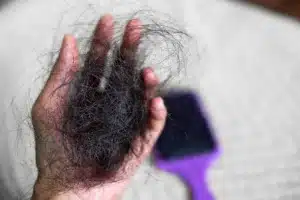Hair loss after giving birth is a common phenomenon that affects many new mothers. It can be a frustrating experience, but it’s important to understand that it’s a normal part of the postpartum period. In this blog post, we’ll explore why hair falls out after pregnancy and provide some tips to help manage hair loss after giving birth.

Why Does Hair Fall Out After Pregnancy?
Hair loss after pregnancy is known as postpartum hair loss or telogen effluvium.
Telogen effluvium is a type of hair loss caused by a variety of stressors to the body including fever, surgery, medications, hormonal shifts, nutritional issues, and more. The journey through pregnancy and childbirth, or even miscarriage, creates a variety of opportunities to develop telogen effluvium in the postpartum period.
During pregnancy, the increased levels of hormones in the body cause hair to remain in the growth phase, resulting in thicker, fuller hair; however, after childbirth, the hormone levels return to normal. The excess hair remaining in the growth phase starts to fall out, usually occurring around three to six months after giving birth.
When hair loss after birth results because of hormonal changes, it is generally referred to as postpartum hair loss. Because the extra hormones resulted in extra hair, when the hormone levels return to normal, the hair loss only results in returning the new mother back to her pre-pregnancy hair levels.
Sometimes hair loss after birth can be more severe. Another factor contributing to hair loss after giving birth is the physical stress of childbirth and its counterparts. This more severe type of postpartum hair loss is often referred to as telogen effluvium.
Additionally, because this type of hair loss is related to severe trauma, we can also see telogen effluvium in patients of major surgery, miscarriages, or people who have had a traumatic near-death experience.
What Helps with Postpartum Hair Loss
New mothers may be able to reduce hair loss after birth by following some of the following techniques:
- Be gentle with your hair: Avoid pulling your hair into tight hairstyles such as braids, ponytails, or buns. These styles can pull on the hair and cause it to break. Instead, opt for loose hairstyles such as a low ponytail or a messy bun.
- Use a wide-tooth comb: Using a wide-tooth comb can help prevent hair breakage. Start combing your hair from the ends and work your way up to the roots.
- Take care of your scalp: A healthy scalp is essential for healthy hair growth. Make sure to keep your scalp clean and moisturized. Avoid using harsh shampoos and conditioners that can dry out your scalp.
- Eat a healthy diet: Eating a healthy, balanced diet can help promote healthy hair growth. Make sure to include plenty of protein, vitamins, and minerals in your diet.
- Consider a new hairstyle: If you’re experiencing significant hair loss, consider getting a shorter hairstyle. This can help make your hair look fuller and hide any thinning areas.
Hair loss after giving birth – Summary
Hair loss after giving birth is a normal part of the postpartum period. Whether it be hormonal postpartum hair loss or the more trauma-induced telogen effluvium, the frustration that comes with it is well understood.
While being gentle with your hair, as the tips above suggest, may reduce the speed and amount of hair that is lost; the best course of action when dealing with any type of hair loss is to see your dermatologist.
At Algow Dermatology, board-certified dermatologist Dr. Dina Strachan is a specialist in hair loss who welcomes anyone with hair loss concerns to make an appointment. Schedule a consultation with our Manhattan dermatologist here!


